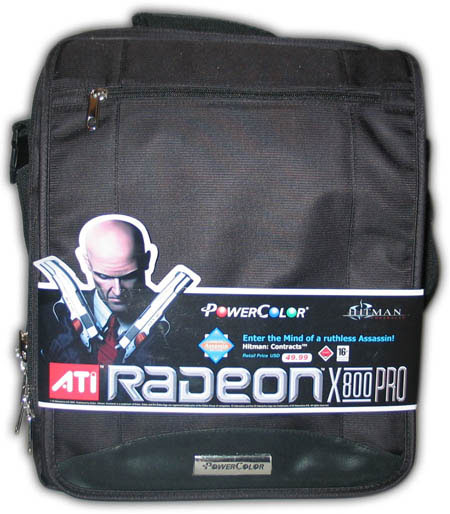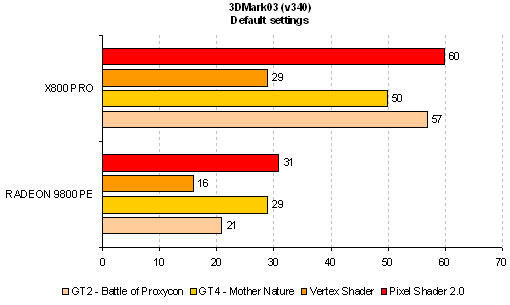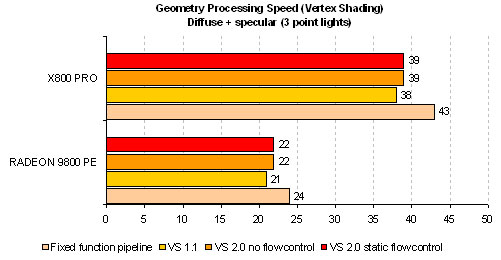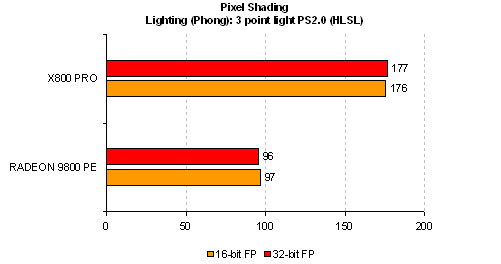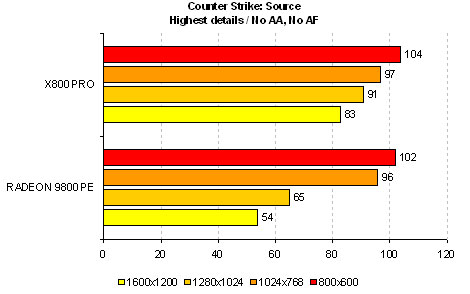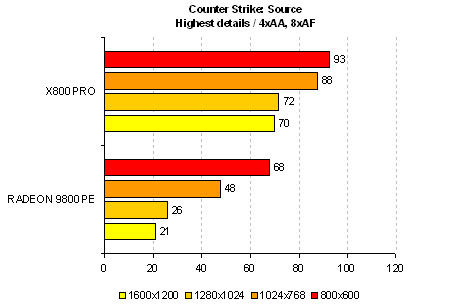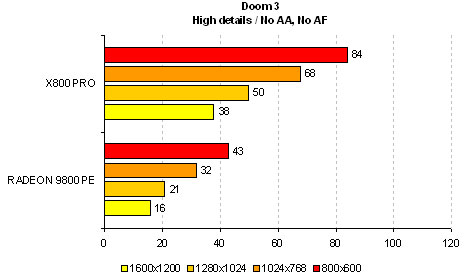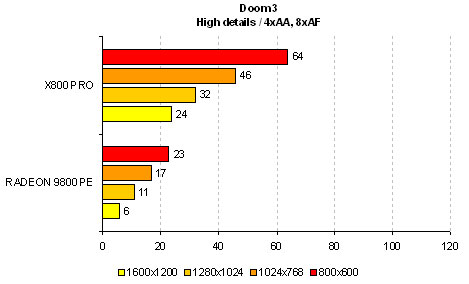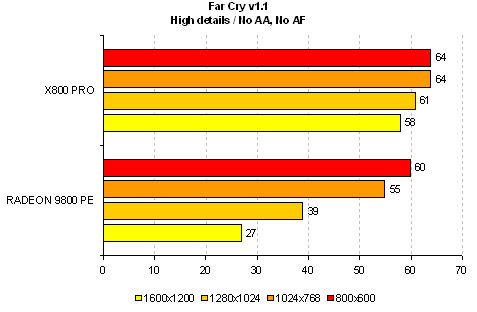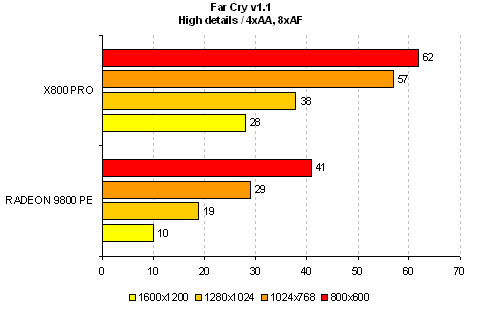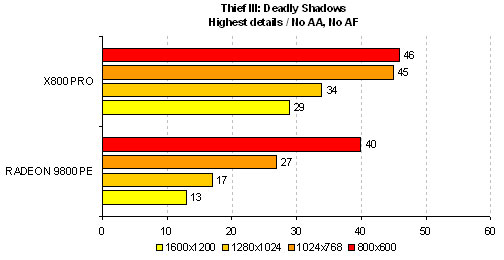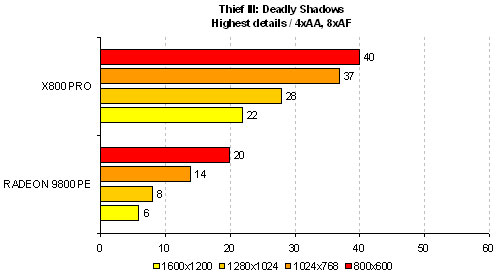PowerColor X800 PRO Limited Assassin Edition is a very solid product with really good accessory assortment and substantial performance. Because of rare and incomparable package, hardware admirers will love every aspect of the card including additional and useful bundle.
Introduction
Around two weeks ago we’ve looked at PowerColor RADEON 9800 Platinum Edition — a mainstream video card based on ATI’s R360 ASIC. What you will find on our review bench today is a high-end PowerColor X800 Pro Limited Assassin Edition from Tul. Tul Corporation is a Tier-1 provider of ATI-based graphic cards. The company is also a leader in providing motherboards and barebone systems. Be sure to check out our PowerColor A350A-VF IGP 9100 motherboard review as well.
If you recall back in 2002, R300 (RADEON 9700) was blasting at full speed with its full availability. Although it was still a .15µ micron process it was a very mature silicon (ATI’s first .15µ chip was the R200) with very few if no flows. R300 was ATI’s greatest success which accounted for best performing DirectX 9 chip. During 2002, ATI was already working on a new design — the R400 which was later canned mainly because of beyond DirectX specifications which could make the chip a bit too avant garde if you will.
So the initial R400 design was scrapped (For time being I assume) and a new core codenamed “Loki” was born. Albeit ATI’s introduction of R420 VPU created quite a stir due to lack of Shader Model 3.0, it isn’t really a long term problem since the refresh part will most likely support it. For current DirectX 9 games most of the effects available through SM 3.0 can be achieved with SM 2.0b which is exposed in DirectX 9.0c. A clear example would be Far Cry where SM 3.0 dynamic branching is as effecient as branching done with SM 2.0b.
Not everyone can afford a top of the line CPU and 1024 MBs of grade ‘A’ memory. In this review I will show you that your old Athlon XP is still here kicking and scoring well above average when combined with high-end GPU.
|
FIND THE BEST PRICES FOR THE PowerColor X800 Pro AT PRICEGRABBER |
VPU Specifications
Let’s take a look at technical specs of our PowerColor X800 PRO Limited Assassin Edition. If you are already familiar with X800 PRO specifications, you’ll notice that this is actually ATI’s original design with PowerColor sticker slapped on the cooler. You won’t find an overclocked core or memory in PowerColor’s package either — just stock clock rates.
| PowerColor |
X800 PRO Limited Assassin Edition |
| VPU (256-bit) |
R420
|
| Chip Architecture |
.13µ low-k process
|
| Transistors |
160 Million
|
| Memory Architecture |
256-bit / up to 512 MBs of GDDR-3
|
| Pipeline Architecture |
12×1 (6 vertex shader pipelines)
|
| Bus Type |
AGP 4X, 8X
|
| Core Clock |
475 MHz
|
| Memory Clock |
450 MHz (900 MHz effective)
|
| RAMDAC’s |
Dual integrated 10 bit per channel 400 MHz DACs
|
| Memory Bandwidth |
28.8 GB / sec
|
| Pixel Fillrate |
5.7 GPixels / sec
|
| Texel Fillrate |
5.7 GTexels / sec |
As I mentioned above, PowerColor X800 PRO is structurally identical to ATI’s R420 design. The VPU has been built by TSMC and features .13µ low-k process. You’ll see stock clock rates, similar to those found on ATI X800 PRO. As all X800 PRO’s the card sports 12 pixel pipelines and 6 vertex shader pipelines. Note that all 16 pipelines can be unlocked on VIVO cards with a bios flash since those do not have a laser mark — the cut prevents you from modding your PRO to XT. Our X800 PRO also features 256 MBs of SAMSUNG K4J55323QF-GC20 memory (GDDR3). Under JEDEC spec the memory chips can reach speeds of around 500 MHz (1 GHz effective).
If you look at features offered by R300 / R350, you’ll see huge similarities when compared to R420. Here is a more detailed list:
SMARTSHADER HD
- Support for Microsoft® DirectX® 9.0 programmable vertex and pixel shaders in hardware
- DirectX® 9.0 Vertex Shaders
- Vertex programs up to 65,280 instructions with flow control
- Single cycle trigonometric operations (SIN & COS)
- DirectX® 9.0 Extended Pixel Shaders
- Up to 1,536 instructions and 16textures per rendering pass
- 2nd generation F-buffer technology accelerates multi-pass pixel shader programs with unlimited instructions
- 32 temporary and constant registers
- Facing register for two-sided lighting
- 128-bit, 64-bit & 32-bit per pixel floating point color formats
- Multiple Render Target (MRT) support
- Complete feature set also supported in OpenGL® via extensions
SMOOTHVISION HD
- 2x/4x/6x Anti-Aliasing modes
- Sparse multi-sample algorithm with gamma correction, programmable sample patterns, and centroid sampling
- Lossless Color Compression (up to6:1)at all resolutions, including widescreen HDTV resolutions
- Temporal Anti-Aliasing
- 2x/4x/8x/16x Anisotropic Filtering modes
- Up to 128-tap texture filtering
- Adaptive algorithm with bilinear (performance) and trilinear (quality) options
3Dc
- High quality 4:1 Normal Map Compression
- Works with any two-channel data format
HYPER Z HD
- 3-level Hierarchical Z-Buffer with Early Z Test
- Lossless Z-Buffer Compression (up to 48:1)
- Fast Z-Buffer Clear
- Z Cache optimized for real-time shadow rendering
- Optimized for performance at high display resolutions, including widescreen HDTV resolutions
VIDEOSHADER HD
- Seamless integration of pixel shaders with video in real time
- FULLSTREAM video de-blocking technology for Real, DivX, and WMV9 formats
- VIDEOSOAP noise removal filtering for captured video
- All-format DTV/HDTV decoding
- Adaptive Per-Pixel De-Interlacing and Frame Rate Conversion (temporal filtering)
DISPLAY FEATURES
- Dual integrated display controllers
- Dual integrated 10 bit per channel 400 MHz DACs
- Integrated 165 MHz TMDS transmitter (DVI 1.0 / HDMI compliant and HDCP ready)
- Integrated TV Output support up to 1024×768 resolution
- YPrPb component output for direct drive of HDTV displays
- Single and dual link external TMDS transmitter support for high resolution and/or multi-monitor DVI configurations
- Compatible with ATIs THEATER video decode and capture devices for VIVO (Video Input / Video Output) configurations on certain X800 graphic cards
ADDITIONAL FEATURES
- Windows® Logo Program compliant
- CATALYST Software Suite
Sporting 12 PS pipelines, 6 VS pipelines and a whopping memory bandwidth of 28.8 GB / sec this card performs really well even without additional 4 PS pipelines which are present on the XT model.
|
FIND THE BEST PRICES FOR THE PowerColor X800 Pro AT PRICEGRABBER |
The Card
PowerColor X800 PRO Limited Assassin Edition arrived in a BIG bag, not a standard cardboard box — more about this later. So you already know what’s under the hood, but let’s take a peek at the card itself.
Sizewise, X800 PRO is pretty short compared to NVIDIA’s NV35 / NV40. It’s definitely a plus for those with smaller cases or SFF PC’s. The card occupies only 1 slot and features standard R420 heatsink + cooler with PowerColor sticker. Nothing special really, but for that price I wouldn’t brag. The backplate offers standard connectors (from the top): VGA 15-pin, S-Video, DVI.
Looking at the back of the card, I found no RAM sinks. I bet modders are happy though as this gives them more freedom and opportunity for creativity.
A top view shows the card in its entirety, including the power connector which is essential for the card to operate at full speed. If you do not connect the power cable, you will be notified with a few beeps at the bootup so don’t panic.
RAM found on our PowerColor X800 PRO comes from SAMSUNG. It’s the GDDR 3 K4J55323QF-GC20 rated at 2.0 ns with maximum frequency of 500 MHz (1000 MHz effective). Note that the card comes clocked at standard 450 MHz so technically there shouldn’t be a problem overclocking it over by 50 MHz (100 MHz effective).
Let’s take a closer look at the bundle.
|
FIND THE BEST PRICES FOR THE PowerColor X800 Pro AT PRICEGRABBER |
Bundle
So you are probably wondering what Limited Assiassin Edition sigifies. First of all, the card does not come in a box, it comes with a huge notebook-type bag where you’ll find all the components and accessories.
The quality of the bag is really great. It doesn’t look or feel cheap. It contains a lot (and I do mean it) of pockets which I simply didn’t count but you have to take my word for it. The inside is made up of two main chambers where you can put bigger items — be it a laptop, papers, folders or your other office-oriented material. In the main chamber you’ll find a pocket for your CD player, additional compartments and pouches to store your stuff. Another great thing is that it can be used as a carrying bag or simply a backpack (it does contain straps, but you have to look for them carefully).
When you open the main pocket of the bag, you will be looking at a little black box. Guess what’s inside? A PowerColor X800 PRO Limited Assassin Edition with the User Manual. Okay, let’s dig a bit deeper. Some of you might feel a bit like a kid under a Christmas tree — heh, I know I did.
Checking other pouches you’ll come upon other accessories. You can see them above and those are:
-
S-Video cables
-
Composite RCA cables
-
RCA to Composite cable
-
RCA to Composite adapter
-
DVI-I-to-VGA adapter
-
HDTV cable
The software bundle isn’t anything special, but it contains Hitman: Contracts, CyberLink DVD software and Driver CD.
|
FIND THE BEST PRICES FOR THE PowerColor X800 Pro AT PRICEGRABBER |
Setup and Installation
Below you will find the complete system configuration as well as benchmarks used in this review.
|
Test system specifications
|
| ABIT NF7-S motherboard — nForce 4.24 drivers Chaintech 420 Watt PSU Athlon Barton XP 2800+ at 2100MHz 768 MBs of Corsair XMMS 3200 LLP RAM Windows XP SP2 DirectX 9.0c |
|
PowerColor X800 PRO Limited Assassin Edition |
|
Benchmarks
|
|
Synthetic benchamrks: 3DMark 2001 SE (build 330) — default settings |
|
Game benchmarks: Counter-Strike: Source (custom demo + FRAPS) |
At the time of writing this review, ATI has released a new set of beta CATALYST video drivers (8.07) which boost performance for all RADEON cards equipped with 256 MBs of RAM, but unfortunetely I was already done with the benchmarks. I divided the benchmarks into two types: synthetic and game benchmarks. If you recall, those are the same benchmarks used in our PowerColor RADEON 9800 Platinum Edition review except for Doom 3. There are four resolution modes I’ve chosen for this review: 800×600, 1024×768, 1280×1024 and 1600×1200.
Please note that I scrapped Richard Burns Rally from the list of game benchmarks. There seems to be a bug when switching to world camera view — this only seems to affect the X800 PRO.
This is a typical hardware installation procedure. I did not uinstall drivers, just swapped the cards and then installed the CATALYST suite. The whole driver suite (drivers + CATALYST Control Center) weighs a hefty 42.3 MBs plus .NET Framework 1.1 which is around 23 MBs. Those on dialup will probably want to install the old control panel which isn’t so bad in my opinion. The new one looks too candyish, is slow and eats up a lot of CPU cycles.
So you’re probably wondering what happens when you combine a medium class system with a high-end PowerColor X800 PRO video card? System limitations tend to appear pretty often, especially at lower resolutions.
|
FIND THE BEST PRICES FOR THE PowerColor X800 Pro AT PRICEGRABBER |
Synthetic Benchmarks
3DMark 2001 SE
Looking back at our theoretical results, we’ll compare them to the actual scores gathered by 3DMark01SE (build 330).
| GPU |
X800 PRO |
RADEON 9800 PE |
| Pixel Fillrate |
2.5 GPixels / sec |
926 MPixels / sec |
| Texel Fillrate |
5.3 GTexels / sec |
2.67 GTexels / sec |
| Polygon Count (1 light) |
171 MTriangles / sec |
70 MTriangles / sec |
| Polygon Count (8 light) |
36 MTriangles / sec |
17 MTriangles / sec |
| Vertex Shader |
360 FPS |
156 FPS |
| Pixel Shader (1.1) |
490 FPS |
202 FPS |
| Advanced Pixel Shader (1.4) |
318 FPS |
139 FPS |
With our PowerColor X800 PRO clocked at standard 475 MHz, Pixel Fillrate (Single-texturing) is roughly 2.5 GPixels / sec where as Texel Fillrate (Multi-texturing) reaches 5.3 GTexels / sec. Polygon Count with only 1 light gives us 171 MTriangles / sec, but when 8 lights are used we get around 36 MTriangles / sec. As you can see from the above results VS and PS scores come out pretty good, but only Shader Model 1.1 and 1.4 are used here.
3DMark 2003
Average frames per second (higher is better)
Since 3DMark 2001 SE supports up to SM 1.4, additional testing was required to see how our X800 PRO did with Shader Model 2.0. Indeed not too shabby as you can see. The four benchmarks I ran stress the most out of the pixel and vertex pipelines.
D3D RightMark
D3D RightMark is a very useful tool for measuring different theoretical throughputs of a graphic card. I ran couple of synthetic tests to stress the PowerColor X800 PRO and compare it with the PowerColor RADEON 9800 PE.
With D3D RightMark you will be able to get the following information about your video card:
- Features supported by your video card
- Pixel Fillrate and Texel Fillrate
- Pixel shader processing speed (all shader models)
- Vertex shader (geometry) processing speed (all shader models)
- Point sprites drawing speed
- HSR efficency
Average frames per second (higher is better)
In this test, we are looking at the vertex shader’s (geometry) processing speed. I chose Diffuse + specular (3 point lights) for our lightning profile which is probably the most useful setting. This will give us peak geometrical throughput. In order to get a clearer overlook, four different shader profiles were used: Fixed Function Pipeline (FFP) VS 2.0 static flow, VS 2.0 no flowcontrol and VS 2.0 static flowcontrol.
You can clearly see a big improvement in X800 PRO’s vertex shader processing when compared to RADEON 9800, especially in FFP mode where standard Transform & Lightning pipeline is stressed.
Average frames per second (higher is better)
Let’s have a look at the pixel shading performance. Lightning (Phong) PS 2.0 shading profile is a very good synthetic test that nicely stresses the pixel pipeline. You can choose all current Shader Models ranging from PS 1.1 all the way up to PS 3.0. In our case we are looking at Pixel Shader 2.0 and 16-bit / 32-bit floating point numbers. At 1024×768, the Lightning (Phong) PS 2.0 benchmark ran flawlessly giving us 177 FPS under 16-bit FP and 176 under 32-bit FP.
|
FIND THE BEST PRICES FOR THE PowerColor X800 Pro AT PRICEGRABBER |
Game Benchmarks
Game Benchmarks: Counter-Strike: Source
The saga continues. The popularity of this game should be beyond anyone’s expectations. Simply put it’s the most popular online game played today. For those not in the know, a few weeks ago Valve invited all Counter-Strike: CZ owners as well as Half-Life 2 coupon holders to take part in Counter-Strike: Source open beta program. Note that after the beta ends, you will need to purchase Half-Life 2 or standalone CS:S.
So what’s the big deal you ask? Well, this version of Counter-Strike is based off Half-Life 2 Source engine which utilizes a very wide range of DirectX 8 / 9 special effects. Those include:
- Diffuse / specular bump mapping
- Dynamic soft shadows
- Localized / global valumetric fog
- Dynamic refraction
- High Level-of-Detail (LOD)
Unfortunately users with DirectX 7 and older hardware will not be able to enjoy the above effects. Here is another interesting bit: Source engine will default GeForce FX cards to DirectX 8.x path, even though it’s a DirectX 9 hardware. Note that CPU limitation will be present throughout this article, even with heavy use of DirectX 9 effects.
Average frames per second (higher is better)
X800 PRO and RADEON 9800 PE both report similar frame rates at 800×600 and 1024×768 which clearly indicates CPU limitation. Even with highest details, our X800 PRO does a terrific job at high resolutions including 1600×1200 which gives an average of 83 FPS.
Average frames per second (higher is better)
With high-end video card like this one, not enabling Antialiasing / Anisotropic Filtering would be a sin. The X800 PRO Limited Assassin Edition from PowerColor passes our test with marvelous scores. Average frame rate doesn’t drop below 70 at 1600×1200 resolution.
With Half-life 2 around the corner (supposedly November 26th), X800 PRO is probably the best bet if you have a mid class system. You should be golden since shader performance improved a lot since the last generation of ATI VPU’s.
|
FIND THE BEST PRICES FOR THE PowerColor X800 Pro AT PRICEGRABBER |
Game Benchmarks: Doom 3
This game needs no introduction, but I will go over some of the game features and technology behind Doom 3. It took the guys at id Software over four years to complete this project. Lead programmer, John Carmack spent an awful lot of time designing the game engine, but his hard work paid off — to some extent since this is first title which houses Doom 3 engine.
Let’s look at some of the engine tech features which are present in Doom 3:
- Unified lightning and shadowing engine
- Dynamic per-pixel lightning
- Stencil shadowing
- Specular lightning
- Realistic bumpmapping
- Dynamic and ambient six-channel audio
However you look at it, Carmack’s lightning engine is the essence of Doom 3. With OpenGL being the primary API, shaders have been put to a heavy use in order to create the realisticly looking environment. Instead of using lightmaps the game engine now processes all shadows in real-time. This technique is called stencil shadowing (Same technology used for Thief III: Deadly Shadows) which can accurately shadow other objects in the scene. There are disadvantage to this method however:
- Requires a lot of fillrate
- Fast CPU is needed for shadow calculations
- Inability to render soft shadows
Let’s take a look at the benchmarks now.
Average frames per second (higher is better)
The drivers I’ve used contain a fix for Doom 3 which greatly improve the game performance. The hot-fix is available with CATLYST 4.9 drivers. Looking at the scores you can clearly see that the X800 PRO does very well across all resolutions. It seems there is a slight fillrate limiation when going from 1280×1600 to 1600×1200.
Average frames per second (higher is better)
Enabling Antialiasing and Anisotropic Filtering produces great scene rendering but at a cost. Slower CPU’s might be brought to their knees when calculation shadow volumes, but at 1280×1024 the gameplay was rather smooth with only slight slowdowns.
High-end ATI video card holders should have pleasent times while playing Doom 3 at high details. Although I was benchmarking on a slower CPU, our PowerColor X800 PRO did not strain away one bit (Except for 1600×1200 when AA / AF was enabled). As you can see twelve pipelines, 256 MB’s of GDDR 3 RAM and high clocks did the trick pretty well. RADEON 9800 PE seems to perform similarly to RADEON 9600 XT in this case.
|
FIND THE BEST PRICES FOR THE PowerColor X800 Pro AT PRICEGRABBER |
Game Benchmarks: Far Cry
The company behind this game is Crytek. It’s pretty much the first title which uses a heavy load of PS 2.0. We are using the full version with 1.1 patch applied (note that patch version 1.2 was withdrawn due to issues with R420 hardware). Anyone who played it will admire the draw distance, beautiful outside vegetation and incredibly spooky indoor environment. The game also features topnotch self-learning A.I and very realistic physics.
Far Cry’s CryEngine is pretty scalable, however you’d need at least DirectX 8 class hardware to enjoy the refractive water effects, real time per-pixel lighting, specular bump-mapping or volumetric effects. As you will see in a second, our PowerColor X800 PRO does extremely well pushing the performance to the limit!
Average frames per second (higher is better)
As I’ve mentioned before in a lot of cases our benchmarks are CPU limited. This also applies to Far Cry where frames per second are close together across all resolutions. Our X800 PRO shows fantastic results, scoring 58 FPS at 1600×1200.
Average frames per second (higher is better)
Even with 4x AA and 8x AF I’m pretty much CPU bound at 800×600 and 1024×768. Things change a bit when we run our tests at 1280×1024 and up. Albeit this is still playable the FPS marks jumps down to 38 and 28 FPS for 1600×1200.
This is probably the first DirectX 9 title that uses plenty of PS 2.0 shaders, but since the game features a great AI and physics you’d want to equip yourself with a fast CPU. I can’t really recommend a perfect setting here, but 1280×1024 with 4xAA, 8xAF seems very enjoyable.
|
FIND THE BEST PRICES FOR THE PowerColor X800 Pro AT PRICEGRABBER |
Game Benchmarks: Thief III Deadly Shadows
This is another DirectX 9 title. The original Thief was pretty successful since this type of game genre did not exist. With the release of Deadly Shadows the most obvious thing you’ll notice is the graphics engine. Also do not forget improved A.I and HAVOK physics. In order to keep the gameplay intensive and moody, developers decided to implement stencil shadows. One positive thing is that stencil shadows can accurately shadow other objects (self-shadowing is done automatically). The pitfall to this technique is performance since it requires three full passes before whole scene can be rendered.
Thief III uses stencil shadows very widely. Since shadow volumes are created by the CPU, you’ll definitely want to equip yourself with a fast one. Let’s take a glimpse at some benchmark results,
Average frames per second (higher is better)
As I mentioned above, there is a great performance hit with stencil shadows and Thief III is all about them. Looking at the scores you may ask yourself is it really worth to play this game? The above are really worst case scenario results because I’ve chosen a very nasty spot to benchmark. There is just a lot going on: big fire place, bumpy walls / floor, dynamic shadows (all using pixel and vertex shading).
With such a powerful graphic card, in our case PowerColor X800 PRO I’m CPU limited at 800×600 and 1024×768 as seen from the above benchmark. An AMD Athlon 64 or Intel ~3.0 GHz CPU would make a huge difference in creating Thief III shadows.
Average frames per second (higher is better)
I got mixed feelings when enabling 4xAA and 8xAF for this title. Although I had to turn off Bloom effect in order for Antialising to function correctly, the performance wasn’t really that great. Plenty of stuttering even at low resolutions. X800 PRO does its job but I have a feeling my Barton just doesn’t cut it.
|
FIND THE BEST PRICES FOR THE PowerColor X800 Pro AT PRICEGRABBER |
Overclocking and Conclusions
In order to find the most stable overclock, I’ve used ATITool which features A.I overclocking ability. Basically the program does the job for you. It increases the clock rates and scans for artifacts. From standard 475 MHz core clock, I was able to reach a stable 515 MHz (artifact-free). As for memory, the highest frequency achieved was 65 MHz above JEDEC specs (500 MHz, 1000 MHz effective), that is 565 MHz (1130 MHz effective) from a standard 450 MHz rate (900 MHz effective).
PowerColor X800 PRO Limited Assassin Edition is a very solid product with really good accessory assortment and substantial performance. Because of rare and incomparable package, hardware admirers will love every aspect of the card including additional and useful bundle. Even though priced a bit higher than other X800 PRO’s, Tul Corporation put together an excellent enthusiast package. If you are looking for serious video performance and cool gadget in form of a sturdy carrying bag, PowerColor X800 PRO Limited Assassin Edition is for you.
With R420 out of the way, it will be interesting to see what ATI brings in next. Most likely the XBOX 2 VPU, R500 and then the PC refresh part the R480.
Pros:
+ Solid performance
+ Great bundle in form of a carrying bag
+ HDTV cable
+ Good overclocker
Cons:
– A bit expensive
– Plain design, no RAM sinks on the back
– Would be nice to see a second game
With 12 extreme pixel pipelines and great assortment, the PowerColor X800 PRO Limited Assassin Edition gets the rating of 9.5 (Extremely Good) out of 10 and Bjorn3D’s Golden Bear Award.
|
FIND THE BEST PRICES FOR THE PowerColor X800 Pro AT PRICEGRABBER |
 Bjorn3D.com Bjorn3d.com – Satisfying Your Daily Tech Cravings Since 1996
Bjorn3D.com Bjorn3d.com – Satisfying Your Daily Tech Cravings Since 1996
